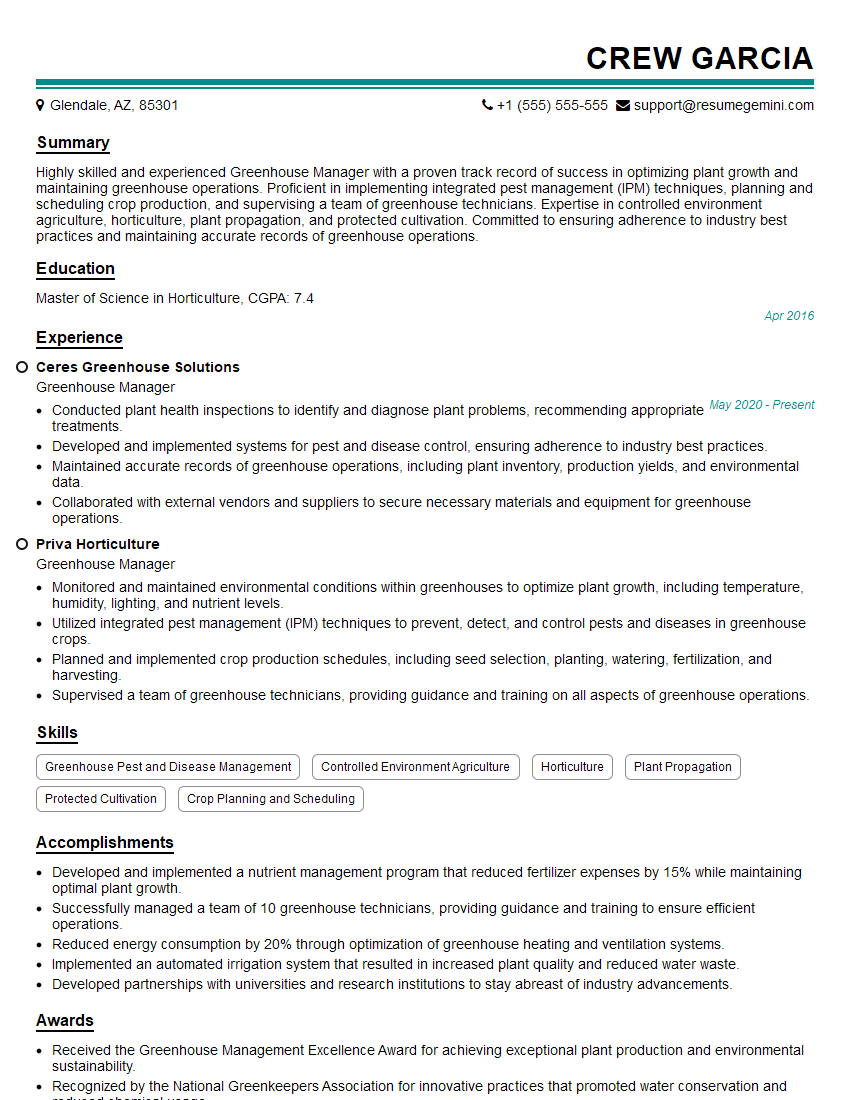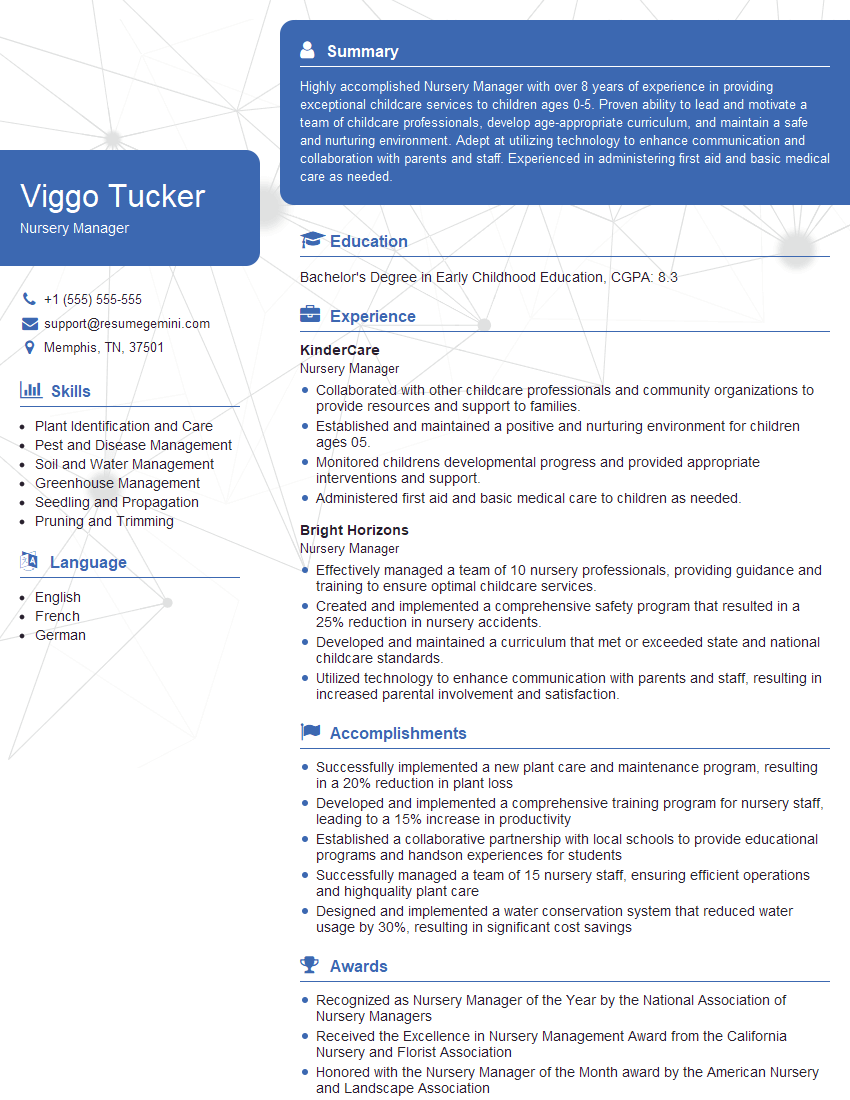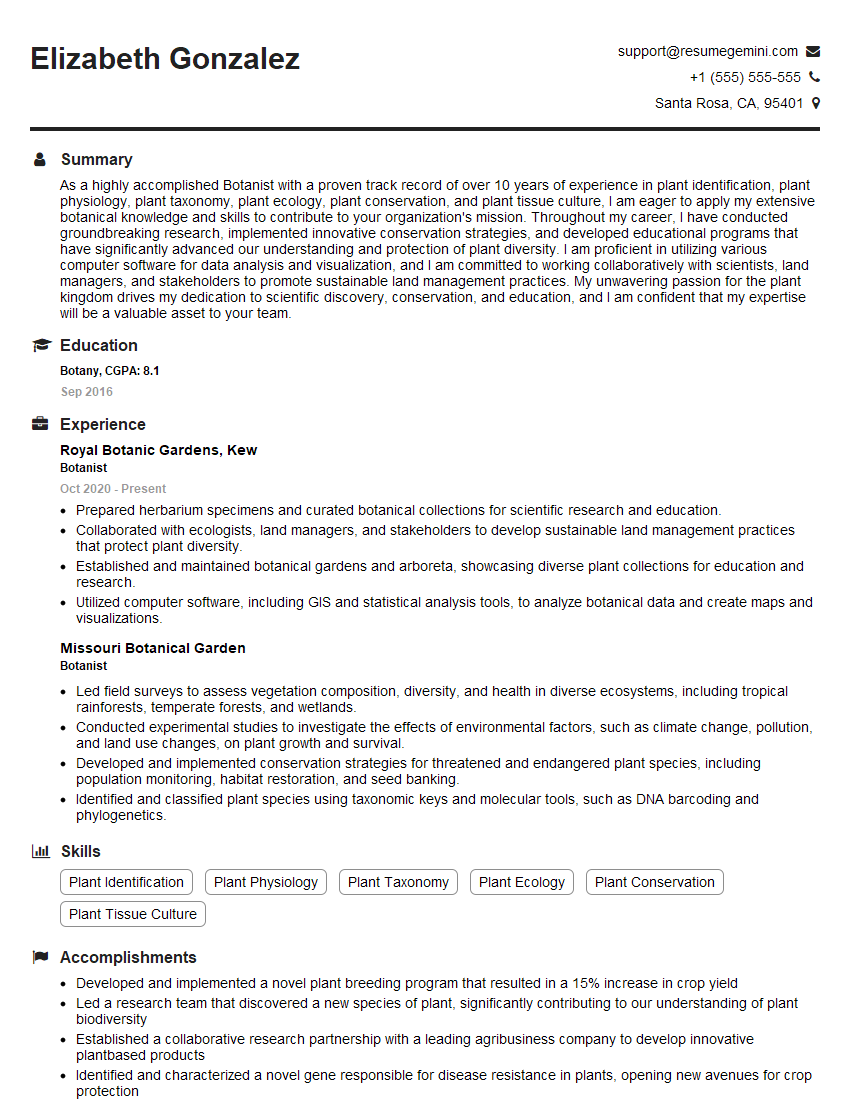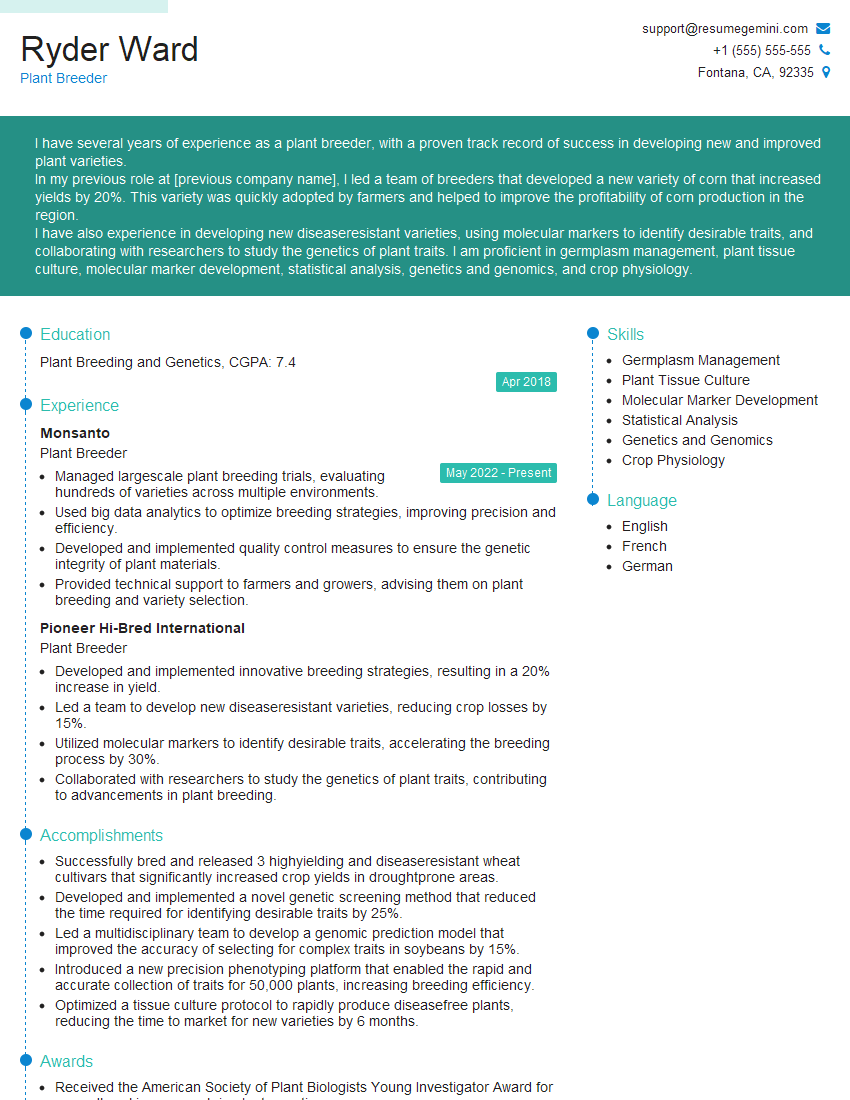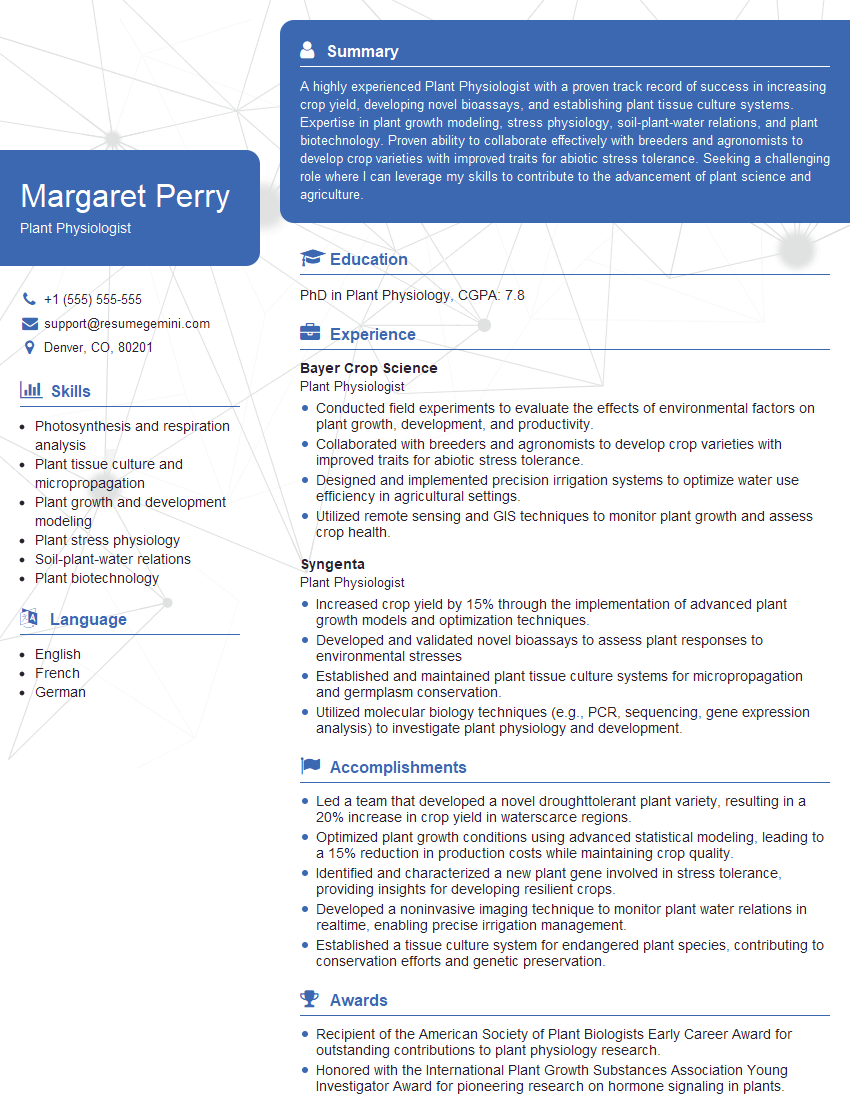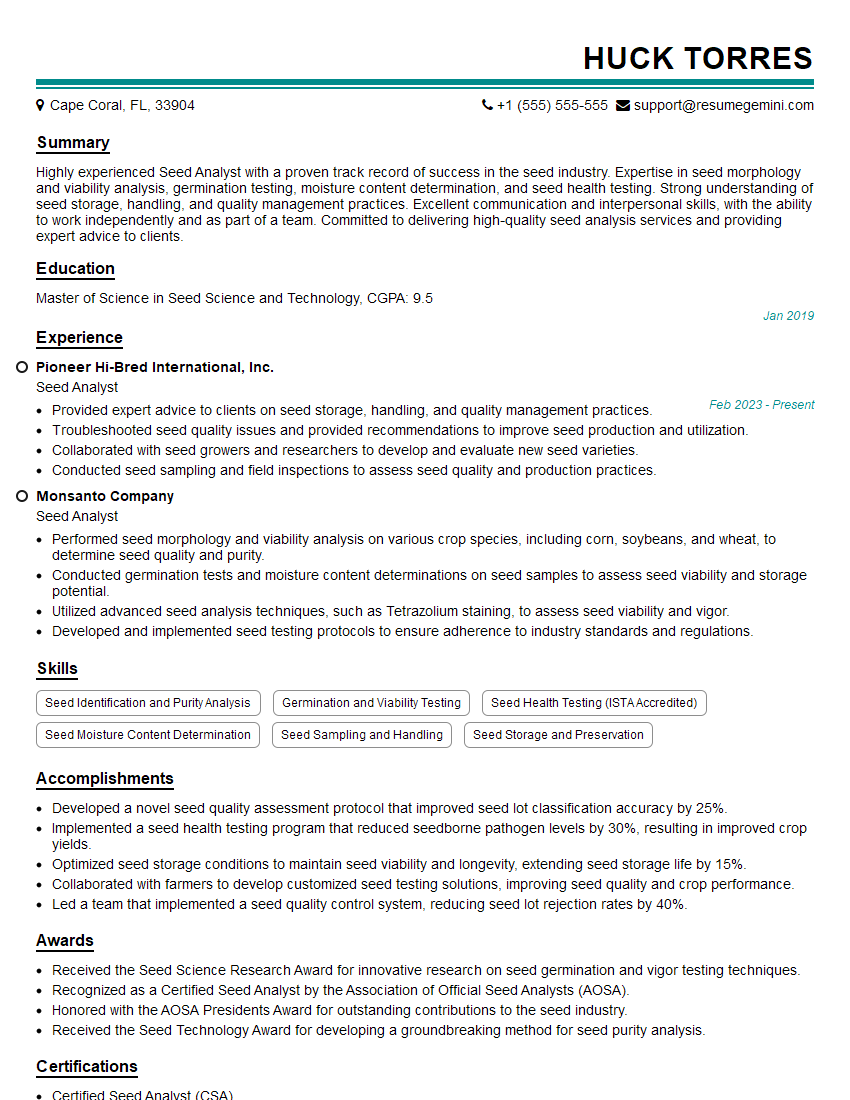Interviews are more than just a Q&A session—they’re a chance to prove your worth. This blog dives into essential Seed Collection and Propagation interview questions and expert tips to help you align your answers with what hiring managers are looking for. Start preparing to shine!
Questions Asked in Seed Collection and Propagation Interview
Q 1. Describe the different methods of seed collection.
Seed collection methods vary greatly depending on the plant species and the scale of operation. Essentially, we aim to collect mature, healthy seeds that are free from disease and damage.
- Hand Collection: This is the most common method for small-scale operations and involves carefully selecting seeds from ripe fruits or seed pods. For instance, collecting tomato seeds involves waiting for the fruit to fully ripen and then extracting the seeds, cleaning them thoroughly, and allowing them to dry.
- Mechanical Harvesting: Large-scale operations often employ machinery like combines or threshers to harvest seeds from crops like wheat, corn, or soybeans. This method is efficient but can lead to seed damage if not properly calibrated.
- Seed-Collecting from the wild: Wild seed collection, often for conservation purposes, requires careful consideration to avoid over-harvesting and damaging the plant population. It involves identifying mature seed heads, selecting healthy seeds, and recording the location and environmental conditions for future reference.
- Commercial Seed Production: Professional seed producers use a combination of controlled pollination, isolation, and specialized harvesting techniques to ensure high-quality, genetically uniform seeds. They often employ cleaning, grading, and processing equipment to ensure consistency.
The choice of method depends on factors like seed type, quantity needed, budget, and available resources. For instance, a small home gardener might hand-collect tomato seeds, while a large-scale farm would use a combine harvester for wheat.
Q 2. Explain the importance of proper seed cleaning and processing.
Proper seed cleaning and processing are crucial for ensuring seed viability, germination rate, and disease prevention. Think of it like preparing ingredients before baking a cake – the better the preparation, the better the final product.
- Cleaning: This removes unwanted material like chaff, stems, and other debris. Methods include screening, winnowing (separating seeds by air), and gravity separation. For example, removing husks from corn seeds is essential for proper storage and planting.
- Grading: This involves separating seeds based on size, weight, and shape. This helps in ensuring uniform germination and improving overall quality. Larger, heavier seeds typically have a higher germination rate.
- Treatment: Seeds may be treated with fungicides or insecticides to prevent disease and pest infestations, particularly if they show signs of damage or are stored for extended periods.
- Drying: Proper drying is vital to reduce moisture content and prevent seed decay. Low-temperature drying helps in preserving seed quality and germination potential.
Failing to properly clean and process seeds can lead to reduced germination, uneven plant growth, and increased susceptibility to disease, ultimately affecting the yield and quality of the crop.
Q 3. What are the key factors affecting seed germination?
Seed germination is a complex process influenced by several internal and external factors. Imagine a seed as a tiny embryo needing the right conditions to ‘wake up’ and start growing.
- Water: Water is essential for seed imbibition (absorption of water), activating metabolic processes and initiating germination.
- Oxygen: Oxygen is crucial for respiration, providing energy for the growing embryo.
- Temperature: Each species has an optimal temperature range for germination. Too cold or too hot, and germination will be inhibited or fail completely.
- Light: Some seeds require light for germination (photoblastic seeds), while others are inhibited by it (negatively photoblastic seeds). This often depends on the plant species.
- Seed Maturity and Viability: Mature and viable seeds are more likely to germinate successfully. Seeds that are damaged, diseased, or have aged too long may have reduced viability.
For example, lettuce seeds germinate best in cooler temperatures (around 70°F), while pepper seeds prefer warmer temperatures (around 80°F). Understanding these factors is crucial for ensuring successful germination and maximizing plant growth.
Q 4. How do you determine seed viability?
Determining seed viability, or the ability of a seed to germinate under favorable conditions, is crucial for assessing seed quality and predicting planting success. Several methods exist:
- Germination Test: This is the most reliable method. A sample of seeds is sown under ideal conditions, and the percentage of seeds that germinate within a specific timeframe is recorded. This provides a direct measure of viability.
- Tetrazolium Test: This is a rapid test that uses a chemical stain (tetrazolium chloride) to assess seed viability. Viable seeds absorb the stain and turn pink or red, indicating active metabolic processes. This is a quick way to check a larger batch but doesn’t show germination rate.
- Visual Inspection: While less accurate, visual inspection can identify obvious damage, decay, or signs of disease. Healthy seeds typically have a firm texture and natural color for that seed species. For example, shriveled or discolored seeds are often less viable.
The choice of method depends on available resources and the level of accuracy required. Germination tests provide the most accurate estimate, but they’re time-consuming. Tetrazolium testing is faster but less precise. Visual inspection is useful for quick checks but may miss subtle issues.
Q 5. Explain different seed storage methods and their benefits.
Seed storage methods are critical for maintaining seed viability and preventing deterioration. Proper storage protects seeds from moisture, insects, rodents, and temperature fluctuations, preserving their germination potential for months or even years.
- Cool, Dry Storage: This is the most common method, involving storing seeds in a cool, dry, and dark place with low humidity (ideally below 30%). A refrigerator or a cool basement are suitable locations. Seeds packaged in airtight containers or sealed bags further protect against moisture.
- Hermetic Storage: This method uses airtight containers to reduce oxygen levels and moisture, significantly extending seed lifespan. Hermetic storage is ideal for long-term preservation, especially for valuable or endangered species.
- Cryopreservation: This technique involves storing seeds at ultra-low temperatures (-196°C or -321°F) in liquid nitrogen. Cryopreservation is used for very long-term storage and is often employed for germplasm conservation and valuable plant genetic resources.
The best storage method depends on the seed type, storage duration, and available resources. Short-term storage often requires cool, dry conditions. Long-term preservation may necessitate hermetic storage or cryopreservation.
Q 6. What are the common seed-borne diseases and their management?
Seed-borne diseases are pathogens that infect seeds and can significantly impact germination, seedling establishment, and overall crop yield. Think of them as hidden threats residing within the seed itself.
- Fungal Diseases: These are extremely common and include species like Fusarium, Alternaria, and Aspergillus. They can cause seed rot, damping-off (death of seedlings), and various foliar diseases.
- Bacterial Diseases: Bacterial diseases, such as Erwinia and Pseudomonas species, can cause seed rot and seedling blight.
- Viral Diseases: While less common, certain viruses can be transmitted through seeds, leading to systemic infections and crop losses.
Management Strategies:
- Seed Health Testing: Testing seeds for pathogens before planting is crucial.
- Seed Treatment: Treating seeds with fungicides or other protectants can significantly reduce disease incidence.
- Crop Rotation: Rotating crops can help break disease cycles and reduce pathogen buildup in the soil.
- Resistant Varieties: Planting disease-resistant cultivars can significantly minimize the impact of seed-borne diseases.
- Hygiene Practices: Proper cleaning and handling of seeds and equipment during planting and harvesting can reduce disease spread.
Effective management requires a combination of strategies tailored to the specific disease, crop, and environmental conditions. The integrated approach is often the most successful strategy.
Q 7. Describe various seed propagation techniques (e.g., cuttings, grafting).
Seed propagation isn’t the only way to produce new plants; many species can be propagated vegetatively, using parts of the parent plant to generate new individuals. This maintains the parent plant’s genetic characteristics.
- Cuttings: This involves taking a stem, leaf, or root cutting from the parent plant and placing it in a suitable medium to induce root development. The cutting then develops into a new plant, genetically identical to the parent. This is common with many shrubs and houseplants.
- Grafting: This is a technique where a part of one plant (the scion) is joined to another plant (the rootstock) to create a single plant. The scion provides the desired characteristics (e.g., fruit quality, disease resistance), while the rootstock provides the root system. This is frequently used with fruit trees, roses and other ornamentals.
- Layering: This involves bending a stem to the ground, burying a portion in soil, and allowing it to develop roots before separating it from the parent plant. Once rooted, it’s cut from the parent and becomes an independent plant. This is useful for plants that don’t root easily from cuttings.
- Division: This is a simple method where a mature plant is physically divided into smaller sections, each with its own roots and shoots. These divisions are then replanted to produce new plants. Common with many perennials and clumping plants.
- Tissue Culture: This is a more advanced technique involving growing plants from small tissue samples in a sterile laboratory environment. It’s useful for producing large numbers of genetically identical plants quickly and efficiently. This is used extensively in horticulture and commercial plant production.
The choice of vegetative propagation technique depends on the plant species, desired number of plants, and available resources. For instance, cuttings are efficient for producing many plants quickly, while grafting is useful for combining desirable traits from different plants.
Q 8. How do you select superior seeds for propagation?
Selecting superior seeds for propagation is crucial for maximizing yield and quality. It involves a multi-step process focusing on evaluating desirable traits. We start by identifying the desired characteristics in the parent plants, such as high yield, disease resistance, or improved nutritional value. Then, we meticulously collect seeds from these superior plants, ensuring proper labeling and storage to maintain their viability and genetic integrity. We might use techniques like progeny testing, where seeds from several parent plants are grown and their offspring evaluated, ensuring consistent quality across generations. For example, if we’re breeding a drought-resistant wheat variety, we’d select seeds from plants that thrived under water-stressed conditions. Furthermore, we may use techniques such as single-seed descent to maintain genetic purity. Finally, thorough record-keeping is paramount throughout the entire process, allowing us to track the performance of different seed lots and refine our selection methods over time.
Q 9. Explain the role of plant hormones in seed germination.
Plant hormones play a vital role in seed germination, acting as chemical messengers that regulate various stages of the process. Gibberellins (GAs) are particularly important, stimulating the production of enzymes that break down stored food reserves in the seed, providing energy for growth. Abscisic acid (ABA), on the other hand, acts as an inhibitor, maintaining seed dormancy. The balance between these two hormones is crucial. For example, during seed imbibition (water uptake), GAs initiate the germination process by breaking down the seed coat and endosperm. If ABA levels remain high, however, the seed might remain dormant even in favorable conditions. Other hormones like cytokinins and auxins also play supporting roles in root and shoot development during germination. Understanding this hormonal interplay allows us to manipulate germination through techniques like seed priming, where we carefully control the hormonal balance to improve germination rate and uniformity.
Q 10. What are the environmental factors affecting seed dormancy?
Environmental factors significantly influence seed dormancy, a state where seeds fail to germinate even under favorable conditions. Temperature is a key factor; some seeds require a period of cold stratification (exposure to low temperatures) to break dormancy, mimicking winter conditions. Light is another important factor; some seeds require light exposure for germination, while others are inhibited by light. Moisture is also crucial; seeds need sufficient water to imbibe and initiate germination. However, excessively high moisture can lead to seed rot. Finally, oxygen availability affects respiration and energy production necessary for germination. For example, seeds of certain desert plants might require high temperatures and minimal moisture to break dormancy, whereas seeds of many temperate species need cold stratification followed by warm temperatures and adequate moisture to germinate. Understanding these factors is key to optimizing germination protocols in different environments.
Q 11. Discuss the importance of seed certification and quality control.
Seed certification and quality control are crucial for ensuring the genetic purity, health, and quality of seeds used in agriculture. Certification programs establish standards for seed production, ensuring that seeds meet specific requirements for germination rate, purity, and freedom from diseases and pests. This involves rigorous testing and inspection throughout the seed production process. Quality control includes checking for physical characteristics (size, shape, color), physiological parameters (germination rate, vigor), and the presence of contaminants like weed seeds or other plant pathogens. For instance, a certified seed lot of corn should have a high germination rate, a low percentage of weed seeds, and be free from corn diseases. This builds trust between seed producers and farmers, ultimately leading to improved crop yields and food security. Without certification, farmers risk using poor-quality seeds that can negatively impact their harvest.
Q 12. How do you identify and manage pests and diseases in seed production?
Pest and disease management in seed production is vital for protecting seed quality and ensuring healthy seedlings. We employ integrated pest management (IPM) strategies that combine cultural, biological, and chemical methods. Cultural controls include crop rotation, sanitation practices, and the use of resistant cultivars. Biological control uses natural enemies of pests, such as beneficial insects or microorganisms. Chemical control employs pesticides as a last resort, using them judiciously and in accordance with regulations. Early detection is crucial; regular field inspections allow early identification and treatment of infestations or diseases before they significantly impact seed production. For example, regular scouting for insect pests like aphids or fungal diseases like fusarium can allow timely intervention, minimizing their impact on seed quality. Proper storage conditions also help to prevent pest and disease infestations during seed storage. A comprehensive approach ensures minimal use of chemical treatments while maintaining seed quality and yield.
Q 13. What are the challenges in seed production and their solutions?
Seed production faces numerous challenges, including climate change, pest and disease outbreaks, and the increasing demand for high-quality seeds. Climate change impacts germination, growth, and yield. Solutions include developing climate-resilient varieties through breeding and employing precision agriculture techniques for optimized water and nutrient management. Pest and disease outbreaks can be mitigated through IPM strategies. The increasing demand for seeds can be met through efficient seed production techniques and technological advancements. Limited access to resources, such as irrigation and quality inputs, hinders seed production in many regions. Solutions involve farmer training, access to credit, and improved infrastructure. Maintaining seed quality during storage, which can be challenging due to temperature and humidity fluctuations, requires improved storage facilities and appropriate seed treatments. Addressing these challenges through research, improved technologies, and policy interventions is crucial for ensuring sufficient and high-quality seed supply.
Q 14. Explain the principles of plant breeding and their relevance to seed production.
Plant breeding principles are fundamental to seed production, aiming to improve crop characteristics through genetic selection and manipulation. Techniques like hybridization, where two different varieties are crossed to combine desirable traits, play a crucial role in developing improved seed varieties. Selection of superior plants based on desired traits, like yield, disease resistance, or nutritional value, is another key principle. Modern breeding techniques incorporate marker-assisted selection (MAS), using DNA markers to identify superior plants early on, speeding up the breeding process. Genetic engineering allows the introduction of specific genes into plants, for example, to enhance pest resistance or nutritional content. These advancements contribute to the production of high-yielding, disease-resistant, and nutritionally enhanced seeds, directly impacting crop productivity and food security. For example, breeding for drought tolerance would involve selecting plants exhibiting traits like deeper root systems or improved water-use efficiency and then developing and distributing improved seeds. The improved seeds would then be further rigorously tested in field trials to validate their performance.
Q 15. Describe different types of seed storage facilities and their requirements.
Seed storage facilities are crucial for maintaining seed viability and genetic integrity. The type of facility depends largely on the species, the intended storage duration, and available resources.
- Conventional cold storage: This is the most common method, involving rooms or walk-in coolers maintained at low temperatures (typically between -18°C and 4°C) and low humidity (around 30-40%). It’s ideal for short to medium-term storage of many common crops. Regular monitoring of temperature and humidity is essential.
- Controlled-atmosphere storage: This advanced method goes beyond simple refrigeration. By controlling the atmospheric composition (reducing oxygen levels and increasing nitrogen or carbon dioxide), this slows down metabolic processes within the seeds significantly, extending their lifespan considerably. This is often used for longer-term storage of valuable germplasm.
- Seed banks: These are specialized facilities, often operating at ultra-low temperatures (-20°C or lower) for long-term storage of diverse seed collections. They have strict protocols for managing seeds, emphasizing security, documentation, and regular quality checks to protect genetic diversity. The Svalbard Global Seed Vault is a prime example of this kind of facility.
Requirements for all facilities include: appropriate climate control (temperature and humidity), proper ventilation to prevent condensation, pest and rodent control, robust security systems to prevent unauthorized access, and a well-documented inventory management system.
Career Expert Tips:
- Ace those interviews! Prepare effectively by reviewing the Top 50 Most Common Interview Questions on ResumeGemini.
- Navigate your job search with confidence! Explore a wide range of Career Tips on ResumeGemini. Learn about common challenges and recommendations to overcome them.
- Craft the perfect resume! Master the Art of Resume Writing with ResumeGemini’s guide. Showcase your unique qualifications and achievements effectively.
- Don’t miss out on holiday savings! Build your dream resume with ResumeGemini’s ATS optimized templates.
Q 16. How do you ensure the genetic purity of seeds?
Maintaining genetic purity is paramount in seed production. It ensures the consistent performance and desired traits of the crop. We employ several strategies:
- Isolation: Physical separation of different varieties or species during flowering to prevent cross-pollination. This might involve spatial isolation (planting distances), temporal isolation (different planting times), or physical barriers (like nets).
- Roguing: Regular field inspections to identify and remove off-type plants (plants that deviate from the desired characteristics of the variety). This is a vital step throughout the growing season.
- Seed multiplication under strict control: Careful selection of parent plants that consistently exhibit the desired traits. Seed multiplication should be carried out in isolated plots or greenhouses to minimise cross-pollination risks.
- Genetic markers (DNA analysis): For critical situations, advanced molecular techniques can be used to verify the genetic purity of seeds, detecting even minor deviations from the expected genotype.
For example, if we’re working with a specific variety of tomato known for its disease resistance, we would rigorously rogue any plants showing signs of susceptibility to that disease during seed production.
Q 17. What are the legal requirements for seed labeling and distribution?
Seed labeling and distribution are subject to stringent regulations that vary by country and region. These regulations are in place to protect consumers and ensure fair trading practices. Key elements typically include:
- Species and Variety Name: The exact botanical name and the cultivar name must be clearly indicated.
- Purity: Percentage of seeds belonging to the declared variety.
- Germination Rate: Percentage of seeds that are expected to germinate under ideal conditions.
- Origin and Lot Number: Tracking information that facilitates traceability.
- Date of packaging and expiry date: To inform the consumer about the seed’s viability.
- Health certifications: Evidence of freedom from specific seed-borne diseases or pests.
Failure to comply with these regulations can result in penalties. Strict adherence is vital for maintaining trust with customers and meeting the requirements of regulatory bodies.
Q 18. How do you handle seed inventory and logistics?
Efficient seed inventory and logistics are essential for maintaining high-quality seeds and meeting market demand. We utilize a robust system involving:
- Database Management: A computerized system for tracking all aspects of the seed supply chain, including seed lots, quantities, storage locations, and movement history.
- Barcoding and RFID tagging: To ensure accurate tracking and identification of individual seed lots from harvest to distribution.
- Warehousing and Storage: Proper storage conditions as discussed in question 1 are maintained throughout the supply chain. This involves regular quality checks and rotations to minimize spoilage.
- Transportation: Seeds are transported under controlled conditions to maintain their quality. This may involve temperature-controlled vehicles or specialized packaging.
- Order fulfillment: A streamlined process for processing orders, ensuring timely delivery and accurate quantity.
Imagine a large-scale seed production company; without such a system, they would struggle to manage the sheer volume of seeds and their associated data, leading to potential losses and inefficiencies.
Q 19. What is your experience with seed testing and analysis?
Seed testing and analysis are critical to evaluating seed quality and viability. My experience spans various testing methods:
- Germination Testing: Determining the percentage of seeds that will germinate under optimal conditions. This involves carefully controlled environmental conditions.
- Purity Analysis: Assessing the percentage of seeds belonging to the declared variety and identifying any weed seeds or inert matter.
- Moisture Content Determination: Measuring the percentage of water in the seeds, which directly affects their viability and storability.
- Disease Testing: Checking for the presence of seed-borne pathogens, using techniques like ELISA or PCR.
- Viability Staining: Using dyes to assess the physiological state of seeds, distinguishing between viable and non-viable seeds.
For instance, we once discovered a significant contamination of a seed lot with a fungal pathogen during routine testing. This allowed for immediate quarantine and prevented widespread distribution of the contaminated seed, saving considerable losses.
Q 20. Describe your experience with different seed sowing methods.
Seed sowing methods vary depending on the species, the scale of operation, and environmental conditions. My experience includes:
- Direct seeding: Sowing seeds directly into the field. This method is cost-effective but may be susceptible to environmental factors like drought or pest attack.
- Seedling raising: Growing seedlings in a nursery before transplanting them into the field. This method offers greater control over the initial growth stages and increases chances of survival.
- Broadcast seeding: Scattering seeds over the surface of the soil. This method is suitable for small seeds and for establishing a dense cover crop.
- Precision seeding: Using specialized equipment to sow seeds at precise locations and depths. This is vital for optimizing plant spacing and yield.
- Hydroponics and aeroponics: Seed germination and seedling growth in soilless environments using nutrient solutions. This is increasingly popular for maximizing efficiency and reducing resource use.
Choosing the right method is crucial for achieving optimal germination rates and plant establishment. For example, delicate seedlings like lettuce benefit from careful seedling raising, while robust crops like corn often tolerate direct seeding.
Q 21. How do you maintain accurate records in seed production?
Maintaining accurate records is paramount in seed production to ensure traceability, quality control, and regulatory compliance. Our record-keeping system includes:
- Detailed field records: Documenting variety, planting date, fertilization practices, pest and disease management, and yield data.
- Seed lot records: Tracking individual seed lots from harvest to distribution, including purity, germination rate, and storage conditions.
- Inventory management: Maintaining accurate counts of seeds in storage, using a database or spreadsheet software.
- Quality control records: Documenting results of seed testing and analysis, including germination tests and disease screenings.
- Sales and distribution records: Tracking seed shipments, customer details, and any relevant feedback.
We use a combination of electronic databases and physical record-keeping to ensure data integrity. Regular audits are conducted to verify accuracy and compliance with regulations. This meticulous system is vital for maintaining the integrity of our seed production process and the trust of our clients.
Q 22. Explain the concept of seed dormancy and its implications.
Seed dormancy is a state where seeds remain inactive despite favorable environmental conditions for germination. This is a crucial survival mechanism for plants, ensuring seeds don’t germinate at inappropriate times, like during a drought or winter freeze. It’s like a plant’s way of hitting the ‘pause’ button on growth until conditions are optimal.
There are several types of dormancy, including physical dormancy (a hard seed coat preventing water uptake), physiological dormancy (inhibition by internal factors like hormone levels), and morphological dormancy (embryo not fully developed). Implications of dormancy include challenges in seed propagation, as breaking dormancy may require specific treatments like scarification (mechanically weakening the seed coat) or stratification (simulating winter conditions).
For example, let’s consider lettuce seeds. They often exhibit physiological dormancy, requiring a period of cold, moist stratification to overcome this and germinate successfully. Conversely, some acacia seeds have hard seed coats (physical dormancy) requiring mechanical scarification before germination.
Q 23. What is your experience with tissue culture techniques for seed propagation?
I have extensive experience with tissue culture techniques, particularly in micropropagation of recalcitrant seeds – those which are difficult to store and germinate conventionally. This involves sterilely culturing seed explants (embryos or other tissues) on nutrient media under controlled conditions to generate plantlets. This approach is vital for preserving rare or endangered plant species with low germination rates or for rapid clonal propagation of superior genotypes.
For example, I’ve successfully used tissue culture to propagate orchids from immature seeds. The process involves sterilizing seeds, culturing them on a growth medium containing essential nutrients and plant hormones, and then transferring the developed plantlets to soil for acclimatization.
Q 24. How do you assess the quality of planting media for seed germination?
Assessing planting media quality is crucial for successful germination. I typically check for several key factors:
- Physical properties: This includes the media’s texture, water holding capacity, aeration, and drainage. A good medium should retain enough moisture but also allow for sufficient air exchange to the roots.
- Chemical properties: I analyze the pH and the levels of essential nutrients. The pH should be optimal for seed germination (generally slightly acidic to neutral), and sufficient nutrients are necessary to support seedling development.
- Biological properties: I assess the media for the presence of pathogens or weeds that could hinder germination or seedling growth. Sterility is crucial.
Practical examples include using a soil-less mix of peat moss, perlite, and vermiculite, ensuring good drainage and aeration. For some sensitive species, I might use sterile agar-based media, minimizing the risk of contamination.
Q 25. Discuss your understanding of different seed dispersal mechanisms.
Seed dispersal mechanisms are incredibly diverse, ensuring the survival and spread of plant species. They can be broadly classified into:
- Wind dispersal (anemochory): Seeds are lightweight and often have structures like wings or plumes (e.g., dandelion, maple seeds).
- Water dispersal (hydrochory): Seeds are adapted to float and travel via water currents (e.g., coconuts, mangroves).
- Animal dispersal (zoochory): Seeds are dispersed by animals through various means:
- Endozoochory: Seeds pass through an animal’s digestive tract (e.g., berries).
- Epizoochory: Seeds attach to animal fur or feathers (e.g., burrs).
- Ballistic dispersal (autochory): Plants actively eject their seeds (e.g., touch-me-nots).
Understanding these mechanisms is vital for predicting seed distribution patterns and optimizing collection strategies. For instance, collecting wind-dispersed seeds requires careful timing, before the wind carries them away.
Q 26. Describe your experience with using various seed-sowing equipment.
My experience with seed-sowing equipment encompasses a wide range, from simple hand tools to precision seeders. I’m proficient in using:
- Hand seeders: Ideal for small-scale operations or specific planting needs.
- Precision seed drills: For larger areas, offering control over seed spacing and depth.
- Broadcast seeders: Suitable for covering larger areas quickly, though less precise in seed placement.
- Pneumatic seeders: For high-volume, efficient sowing, especially in large-scale agricultural settings.
The choice of equipment depends on factors like the scale of operation, the type of seeds, the soil type, and the desired level of precision.
Q 27. What are your strategies for optimizing seed germination rates?
Optimizing seed germination rates requires a multi-pronged approach:
- Seed quality: Starting with high-quality seeds is paramount. Testing germination potential beforehand is crucial.
- Environmental conditions: Maintaining optimal temperature, moisture, and light conditions is vital. These vary depending on the species.
- Planting media: Using a suitable planting medium with good aeration, water retention, and appropriate nutrient levels is essential.
- Pre-sowing treatments: Techniques like scarification, stratification, or priming can overcome dormancy and improve germination rates.
For example, I might use bottom heat to increase germination temperature for slow-germinating species, or employ pre-soaking to improve water uptake for hard seeds. Continuous monitoring and adjustment of these factors are essential for success.
Q 28. Explain the importance of maintaining accurate seed production records.
Maintaining accurate seed production records is critical for several reasons:
- Tracking seed performance: Records allow analysis of germination rates, seedling vigor, and other parameters over time, aiding in selecting superior seed lots.
- Quality control: Documentation helps track the origin, processing, and storage conditions of seeds, ensuring consistent quality.
- Inventory management: Accurate records ensure adequate seed supply, preventing shortages and waste.
- Legal compliance: In some cases, detailed records are necessary to comply with regulations regarding seed production and distribution.
- Research and development: Data on seed performance can inform research into seed improvement, storage techniques, and other aspects.
My record-keeping system includes details on seed source, collection date, germination tests, storage conditions, and any treatments applied. This allows for traceability and ensures repeatability in seed production.
Key Topics to Learn for Seed Collection and Propagation Interview
- Seed Physiology: Understanding seed dormancy, germination, viability, and longevity. Practical application: Assessing seed quality and developing appropriate storage strategies.
- Seed Collection Techniques: Best practices for harvesting different seed types (e.g., fruits, pods, cones). Practical application: Minimizing seed damage and contamination during collection.
- Seed Processing and Cleaning: Methods for removing impurities, separating seeds by size and weight, and assessing seed purity. Practical application: Ensuring high-quality seeds for propagation.
- Seed Storage and Preservation: Principles of seed storage, including moisture content, temperature, and oxygen control. Practical application: Maintaining seed viability over time and preventing deterioration.
- Propagation Methods: Understanding different propagation techniques (e.g., direct sowing, transplanting, vegetative propagation). Practical application: Selecting the most suitable method based on species and environmental conditions.
- Seed Germination and Emergence: Factors influencing seed germination, including temperature, light, and moisture. Practical application: Optimizing germination conditions for maximum seedling vigor.
- Seed Pathology and Disease Management: Identifying and controlling seed-borne diseases. Practical application: Implementing preventative measures to ensure healthy seedlings.
- Seed Legislation and Regulations: Understanding relevant regulations regarding seed production and trade. Practical application: Ensuring compliance with legal requirements.
- Data Management and Record Keeping: Importance of accurate data recording throughout the seed collection and propagation process. Practical application: Tracking seed quality, germination rates, and other relevant parameters.
- Sustainable Seed Production Practices: Implementing environmentally friendly practices to minimize impact on biodiversity and ecosystems. Practical application: Reducing reliance on chemical treatments and promoting sustainable agricultural practices.
Next Steps
Mastering Seed Collection and Propagation opens doors to exciting career opportunities in horticulture, agriculture, conservation, and research. To significantly enhance your job prospects, crafting an ATS-friendly resume is crucial. ResumeGemini is a trusted resource to help you build a professional and impactful resume that highlights your skills and experience effectively. Examples of resumes tailored specifically to Seed Collection and Propagation are available to guide you.
Explore more articles
Users Rating of Our Blogs
Share Your Experience
We value your feedback! Please rate our content and share your thoughts (optional).
What Readers Say About Our Blog
Hello,
We found issues with your domain’s email setup that may be sending your messages to spam or blocking them completely. InboxShield Mini shows you how to fix it in minutes — no tech skills required.
Scan your domain now for details: https://inboxshield-mini.com/
— Adam @ InboxShield Mini
Reply STOP to unsubscribe
Hi, are you owner of interviewgemini.com? What if I told you I could help you find extra time in your schedule, reconnect with leads you didn’t even realize you missed, and bring in more “I want to work with you” conversations, without increasing your ad spend or hiring a full-time employee?
All with a flexible, budget-friendly service that could easily pay for itself. Sounds good?
Would it be nice to jump on a quick 10-minute call so I can show you exactly how we make this work?
Best,
Hapei
Marketing Director
Hey, I know you’re the owner of interviewgemini.com. I’ll be quick.
Fundraising for your business is tough and time-consuming. We make it easier by guaranteeing two private investor meetings each month, for six months. No demos, no pitch events – just direct introductions to active investors matched to your startup.
If youR17;re raising, this could help you build real momentum. Want me to send more info?
Hi, I represent an SEO company that specialises in getting you AI citations and higher rankings on Google. I’d like to offer you a 100% free SEO audit for your website. Would you be interested?
Hi, I represent an SEO company that specialises in getting you AI citations and higher rankings on Google. I’d like to offer you a 100% free SEO audit for your website. Would you be interested?
good
